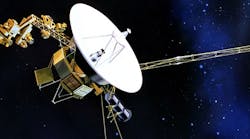If the speed of light is 186,363 miles per second, and it takes a radio signal 19.5 hours to go from transmitter to receiver, what is the distance between the transmitter and receiver? The answer is 13,082,682,600 miles. Yes, about 13 billion miles, give or take a few million miles rounding error. That’s about how far away the Voyager 1 spacecraft is from Earth. A twin spacecraft called the Voyager 2 is much closer to earth, at a bit over 10.7 billion miles away.
We are addicted to near-instantaneous two-way communications. With the Voyagers, a round trip two-way contact takes about 39 hours for command and control, telemetry, and data. Inconvenient, but amazingly still doable.
Both Voyagers were launched about two weeks apart in 1977 from Cape Canaveral. Their goals were to explore the most remote planets in our solar system: Jupiter, Saturn, Uranus, and Neptune. And these goals were met during the 1980s. These flybys delivered amazing photos of the planets and their moons back to NASA that you can see on the agency’s website.
And these two “ancient” spacecraft are still going strong. As of now, both have left the solar system and are headed into deep space. But NASA is still communicating with them. The data rate, which topped out at 115.2 kb/s when the spacecrafts were new and close, is now down to 1kb/s or so at the current distances.
It is astonishing that a radio wave can travel so far. Imagine the signal attenuation. It brings new meaning to the term path loss. The free space path loss is computed with the expression:
dB = 37 dB + 20log(f) + 20log(d)
Here, f is the frequency in MHz and d is the distance in miles. The Voyager 1 used two frequencies, 2.3 GHz in the S band and 8.4 GHz in the X band. Using the lower frequency and the previously estimated 13 billion miles distance, the path loss is:
dB = 37 + 20log(2,300) + 20log(13,000,000,000)
dB = 37 + 67.3 + 202.3 = 306.6 dB
It’s a miracle we can still pick up a signal with that much loss. The Voyager transmitter puts out 23 watts, but it is the antenna that boosts that signal considerably. Its 3.7 meter (12 ft) parabolic dish has a gain of about 57 dB.
At the receiving end of the link is one or more big dishes. There are several large antennas at NASA’s Deep Space Network stations, such as Goldstone in the U.S., Canberra in Australia, or near Madrid in Spain. There are six antennas—one 26 meters (85 ft), four 34 meters (112 ft), and one 70 meters (230 ft)—each having super cooled front-ends for low noise. Using the 70 meter Goldstone dish gives the signal an 82 dB boost. The antennas can also be arrayed to produce more gain and improved reception.
The whole point of this discussion is obvious. We can boost the transmitter power as much as the system power source will let us, but it is the characteristics of a good gain antenna that lets us go the distance. It’s the antenna that really delivers signal increase, if you can stand for the size of it. Furthermore, remember the greater the gain the narrower the beamwidth, so you need to orient the antennas so they can see one another.
The success of any radio system lies with the antennas. While parabolic dishes are still used, the trend is toward phased arrays with beamforming. Such antennas are beginning to show up in most new system designs today. Add to that the various MIMO methods that further increase coverage as well as data speed.
But as good as the antenna is it cannot solve the time delay problem. Propagation speed tops out at the speed of light. We haven’t figured out how to go faster than that…yet.
Check out the Voyager and some of its photos at the NASA website.

